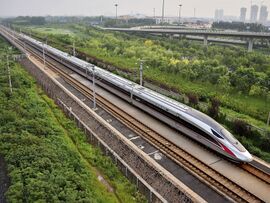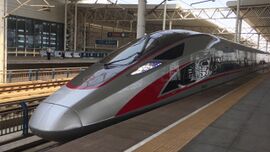Zhenia National Express
 | |
| Dates of operation | 1974–Present |
|---|---|
| Track gauge | 1,435 mm (4 ft 8 1⁄2 in) Standard gauge |
| Headquarters | Changan, Zhenia |
| Website | www.znx.zhen |
The Zhenia National Express (Zhenian: 진국고속철도), commonly stylized as ZNX, is Zhenia's intercity high-speed rail network operated by the ZhenRail. It was constructed to connect major population centers located in both mainland Zhenia and the Danguk Peninsula, as well as linking major cities and distant segments of the Golden Arc region to Donggyeong in order to revitalize passenger transport via rail. With a length of almost 20,000 kilometers as of 2019, it is one of the most extensive high-speed rail networks in the world.
Construction of high-speed lines in Zhenia began in the mid-1960s, with the first lines, the Donggyeong-Changan line, commencing service in March 1, 1974. Further developments resulted in the completion of the Trans Golden Arc line in 1984, the Shinhang-Ariul line in 1989 and later other developments, ultimately resulting in 94% of Zhenians living within 100 kilometers from their nearest high-speed rail station. ZhenRail currently defines the term "high-speed railway" as any line capable of passenger services at or exceeding 250 km/h on its routes.
The maximum speed for trains in regular service is at 400 km/h, although signal and infrastructure systems allow for a theoretical maximum speed of 430 km/h. While initial trains operated at speeds around 240 km/h, later EMU trains brought up the average speed to around 350 km/h. Maglev trains fitted with linear motors, estimated to have a maximum speed of over 500 km/h, are currently under testing in the Donggyeong-Changan line as of 2019, with the first units expected to enter service in 2025.

